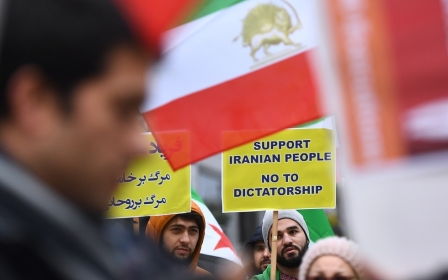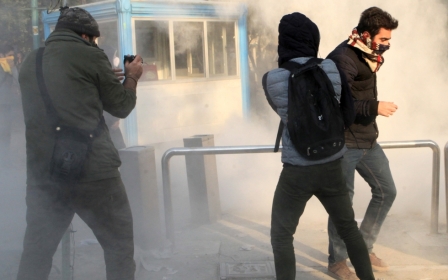Iran unrest: Will it happen again?

In a lengthy interview, prominent Iranian sociologist Maghsood Farasatkhah was recently asked if economic hardships were the root cause of the recent protests in Iran. Farasatkhah replied: "I guess the root causes of these protests are more than that." He argues that the Iranian state has defined its "self" as any other states including the democratic ones.
However, the problem in Iran is that the system is not prepared to recognise the "others" and their rights. It is Iran's governance, which is based on this myopic worldview, that causes discrimination and disparities, economic inequality including Iran's monumental wealth and income gaps. That is the root cause, Farasatkhah argues.
Between 2009 and 2018
Farasatkhah maintains that there are four "others" in Iran's society that the political system fails to recognise. First, a wide range of "political others", a group that includes those that believe in non-violent opposition to the government such as the reformists. Second, cultural and ideological others. The middle class, intellectuals and artists shape this group.
Third, others who define themselves based on their profession such as trade unionists and journalists. And finally, "social others", a group composed of a large faction of Iranian women who oppose the patriarchal, male-dominated order.
Two factions in Iranian society have the potential to shape mass protests
Geographically, the recent protests covered an area larger than the 2009 upheavals that followed the disputed election of former president Mahmoud Ahmadinejad. The protests spread to more than 80 cities and towns. However, in terms of the numbers of participants, these protests were not comparable to the 2009 demonstrations, in which hundreds of thousands poured to the streets of large cities, including the capital city of Tehran.
The question thus becomes why a popular, mass movement similar to the 2009 uprisings did not arise this time. This, despite the fact that Iranian police and security forces refrained from using large-scale violence, compared to 2009.
Two groups in Iranian society have the potential to shape mass protests. First, the poor and deprived sectors that struggle for survival. According to a July 2017 report prepared by the Ministry of Roads and Urban Development, 33 percent of Iran's population lives under the poverty line.
One of the most significant riots involving this population group occurred in 1995, when Iran's inflation rate hit 50 percent during the presidency of the late Ayatollah Hashemi Rafsanjani due to his economic liberalisation policies.
Thousands living in the poor neighbourhood of Islamshahr, in the outskirts of Tehran, staged an angry demonstration. The adjacent poor neighbourhoods joined the protesters almost immediately. The rioters, who moved toward Tehran, were faced with Revolutionary Guards forces that suppressed their protests.
Interestingly, despite its large size, this section of the population has never had a leader to represent its demands. When one looks to the mass upheavals of 1999 and 2009, the backbones of which were middle-class urbanites, the protesters' demands were all of a civil nature, including social liberties, freedom of expression, and opposition to the imposition of strict Islamic codes.
The demands notably absent were those pertaining to economic hardships and inequality, including monumental wealth and income gaps.
Many of the poor are religiously very conservative and consequently refuse to involve unrest against a government that bases its ideology on Islam
The recent protests were no exception. While leadership of any kind was absent in general, this was particularly the case regarding leadership representing the low-income, working class. As such, although some of the members of this faction participated in the protests, especially in smaller cities, they did not come out in droves because no leadership existed to mobilise and lead them.
Another reason explaining this population's absence in the protests may be that a large portion of this faction shapes the political base of the government. Many of the poor are religiously very conservative and consequently refuse to get involved in unrest against a government that bases its ideology on Islam.
The second group in Iranian society that can shape mass movements is the middle-class urbanites. All four groups of "others" defined by Farasatkhah can be found in this sector of the Iranian population.
This group, that comprises the backbone of the 2009 mass uprisings, has chosen a movement and leadership for itself: the reformists, led by former Iranian president Mohammad Khatami. It was because of Khatami's support for Mir Hossein Mousavi, Iran's former prime minister, who after two decades of living in isolation reappeared on the Iranian political stage, ran for president in 2009, and emerged as the leader of the so-called Green Movement.
It was also as a result of Khatami's support that Hassan Rouhani, a political figure unknown to the public, emerged from the ether in 2013 to win the presidential race in the first round, much to the surprise of all analysts, even those in Iran.
The reform movement
Theoretically, the reform movement demands the establishment of a civil society where civil rights and democracy are respected. Rouhani is a centrist who has never been a reformist, yet is now supported by the reformists. During his 2017 presidential election campaign, in order to attract the reformists' votes, he clearly shifted from a centrist to a reformist.
In any event, the second faction also did not massively participate in the recent protests for three reasons.
First, because the Mashhad protests began with the slogans of "Death to Rouhani", it was widely believed that the scenario was orchestrated by the hardliners to force Rouhani to resign.
Members of the middle class, who lived in large cities and who had overwhelmingly voted for Rouhani a mere six months ago, did not see any reason to join the demonstrations, which could have jeopardised Rouhani's position in favour of their opponents, the conservatives.
Second, on the second day, violence erupted, as crowds smashed the windows of state buildings and set fires in buildings and in the streets. The view that Iran can quickly roll into chaos, similar to what occurred in Syria, became widespread and was reflected on the social networks before the government blocked them.
This created a popular fear that prevented city dwellers from joining the demonstrations.
Finally, the Association of Combatant Clerics (not to be confused with the ultra-conservative organisation of Combatant Clergy Association), which Khatami heads, distanced itself from the protests in the strongest words by issuing the following statement: "Without doubt the Iranian people are confronted with difficulties in their daily lives … and have the right to peacefully demand and protest.
"But the events of recent days have shown that opportunists and troublemakers have exploited the demonstrations to create problems, insecurity, and destroy public buildings, while insulting sacred religious and national values."
There is no doubt that a combination of complex social, political and economic factors – first of all the overt favouritism toward the supporters of the system (khodi) and the discrimination against, and pressure on, the rest of the population (na-khodi) – will most likely lead to more unrest in the future.
However, as long as the first group remains leaderless and has not turned its back on the system, and if the second group remains loyal to the reform movement led by Mohammad Khatami, the emergence of a massive uprising "threatening the survival of the system" in the foreseeable future is unlikely.
After all, although the reformists oppose the "deep state" iron hand policies, they do not seek to topple the system.
- Shahir Shahidsaless is an Iranian-Canadian political analyst and freelance journalist writing about Iranian domestic and foreign affairs, the Middle East, and the US foreign policy in the region. He is the co-author of Iran and the United States: An Insider’s View on the Failed Past and the Road to Peace. He is a contributor to several websites with focus on the Middle East as well as the Huffington Post. He also regularly writes for BBC Persian. He tweets @SShahisaless.
The views expressed in this article belong to the author and do not necessarily reflect the editorial policy of Middle East Eye.
Photo: Iranians chant slogans as they march in support of the government near the Imam Khomeini grand mosque in the capital Tehran on December 30, 2017 (AFP)
Middle East Eye propose une couverture et une analyse indépendantes et incomparables du Moyen-Orient, de l’Afrique du Nord et d’autres régions du monde. Pour en savoir plus sur la reprise de ce contenu et les frais qui s’appliquent, veuillez remplir ce formulaire [en anglais]. Pour en savoir plus sur MEE, cliquez ici [en anglais].






